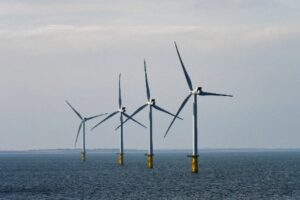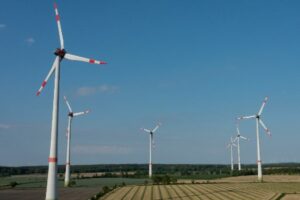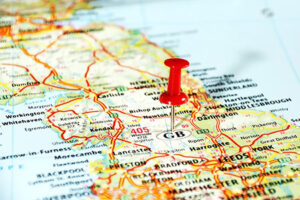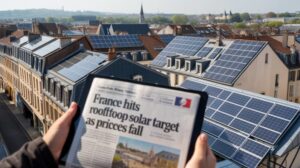Wind Energy Definition
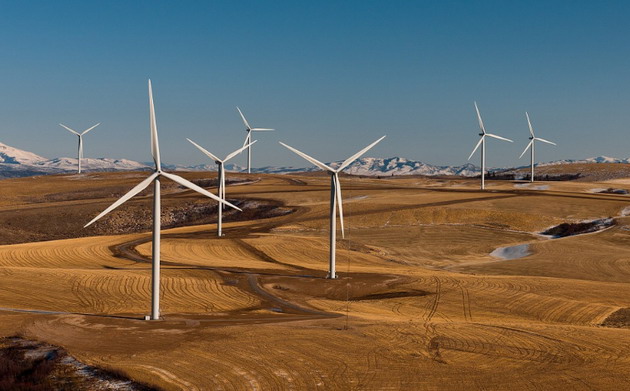
To define wind energy we need to start by going back to ancient times when mankind used the power of the wind to navigate on the sea, grind grain, pump water, and nowadays to generate clean electricity using wind turbines.
Wind on our planet is produced by the Sun that heats in an uneven way the surface of the Earth.
The different layers of air in the atmosphere are heated unevenly by the Sun, which creates a movement in the atmosphere (a layer of warmer air moves up, while a layer of colder air moves down) that we call ‘the wind’.
What is Wind Energy?
Wind energy can be defined today as the kinetic energy of the moving air that is turned into mechanical energy by the spinning wind turbines or windmills, and this mechanical energy is then turned into electrical energy (clean electricity) by a generator, or is used to grind grain, pump water, navigate on the sea, etc.
The large atmospheric winds on our planet are also created by the Sun due to the fact that the surface near the equator receives more heat from the Sun than the areas at the poles.
Being produced by the Sun (which is considered a renewable energy resource), the wind is also a renewable resource of clean power that can help mankind to reduce its dependence on fossil fuels, which would definitely reduce the level of air, water and soil pollution on the planet.
Today, wind energy is mostly used to generate clean electricity with the help of very large wind turbines installed in open areas on the sea (offshore), or on the land (onshore), where the winds are strong and continuous.
How Do Wind Turbines Work?
I already mentioned that wind energy is mostly used today to generate clean electricity using large wind turbines installed in open areas on land or on the sea.
There are two different types of wind turbines used to produce wind power.
1. Horizontal Axis Wind Turbines – HAWT
This is the most common wind turbine used for large scale energy generation on the entire planet, both onshore and offshore.
Horizontal axis wind turbines usually use a turbine with three blades, but on the field, we can also find very tall wind turbines that are using only two blades.
This type of wind turbine consists of a turbine with two or three blades, which rotates under the action of the wind.
In this case, the kinetic energy of the wind is turned into mechanical energy by the rotating turbine.
The rotational speed of the turbine is pretty low, and this is the reason why the turbine is connected to a gearbox through the main shaft.
The gearbox increases the rotational speed of the rotor to reach the level required by the generator to start producing electricity.
The wind doesn’t blow from the same direction all the time, and this is the reason why HAWT’s use a yawn mechanism that rotates the blades of the turbine to face the wind.
The electricity produced by the turbine will be sent to the power station and from there in the grid where will be used to power homes and businesses along with electricity produced from other sources of power (clean or fossil).
2. Vertical Axis Wind Turbines – VAWT
Vertical axis wind turbines are not very common today because they are not used for large scale energy generation.
There are two main types of vertical axis wind turbines:
1. The Savonius model
This old model of VAWT was first used by the Persians three and a half thousand years ago.
2. The Darrieus model
This type of VAWT uses three blades revolving around a vertical shaft. Each blade is hit by the wind at a different angle.
The models that use the airfoil design, generate lift when rotating under the action of the wind.
The generator is located at the bottom of the structure and can generate power without needing a gearbox.
VAWT’s don’t need a yawn mechanism to point them in the wind because they can operate very well even in turbulent winds.
VAWT’s are used today mainly to generate power at small scale because they are less reliable and also less efficient compared to HAWT’s.
World’s Largest Wind Turbines Today
In this top we can find the largest horizontal axis wind turbines, both onshore and offshore.
1. Samsung S7.0-171
This is a three-bladed horizontal axis wind turbine built by Samsung with an output of 7 MW (megawatt) that is reached at a wind speed of 11.5 m/s.
The rotor has a diameter of 171.2 m (561.68 ft), and the swept area is 23,020 m2.
This wind turbine works both onshore and offshore and reaches an overall height of 196 m (643 ft).
2. Enercon E-126 7.580
This is also a three-bladed horizontal axis wind turbine, but is created only for the land (onshore use).
Enercon E-126 7.580 is the biggest direct drive wind turbine in the world (there is no gearbox used).
Being a wind turbine built for land use, the hub is located very high (135 m), and the blades are quite short.
Enercon E-126 has an output of 7.58 MW at a wind speed of 16.5 m/s.
The blades are short, so the diameter of the rotor is only 127 m (416 ft).
Due to the fact that the blades are shorter, the swept area is only 12,668 m2.
The overall height of the wind turbine is 198 m (649 ft).
3. Siemens SWT-8.0-154
Siemens SWT-8.0-154 is an 8 MW three-bladed horizontal axis wind turbine that can be installed both onshore and offshore.
The rotor has a diameter of 154 m (505 ft), and the swept area is 18,600 m2.
The hub is located at an altitude of 120 m (393 ft), and the overall height of the turbine is 197 m (646 ft).
4. MHI Vestas Offshore V164-9.5 MW
This was by 2018, the largest three-bladed horizontal axis wind turbine available for offshore use.
MHI Vestas Offshore V164 has an output of 9.5 MW.
The diameter of the rotor is 164 m (538 ft), and the swept area is 21,124 m2.
The overall height of the turbine is 220 m (722 ft).
5. General Electric Haliade-X
In 2019, this is the largest three-bladed horizontal axis wind turbine available for offshore use with an output of 12 MW.
The rotor has a diameter of 220 m (721 ft), and the swept area is a whopping 38,000 m2.
The hub is located at an altitude of 150 m (492 ft), and the overall height of the turbine is 260 m (853 ft).
This offshore wind turbine generates 67 GW (gigawatt) every year, which is enough to power up to 16,000 households.
How Does A Wind Power Plant Work?
Wind power plants, both onshore (on land) and offshore (on sea) rely on a group of large horizontal axis wind turbines installed in the same location that work day and night to generate clean electricity.
Onshore wind power plants are usually located in open areas where the wind blows freely without being blocked by large trees, buildings, hills, mountains, etc., to ensure a continuous production of energy.
Offshore wind power plants use larger horizontal axis wind turbines that are installed not very far from the shore in an area where they don’t bother the population living on shore or the marine traffic in the area.
On sea, the wind blows freely day and night, which means that these areas located far from people, but not very far from shore, are ideal for wind energy generation that can power with green electricity hundreds of thousands of households.
Because wind is an intermittent source of energy, the electricity produced by the wind power plant needs to be first collected by a power station before being sent into the grid.
On sea, the wind blows freely day and night, which means that these areas located far from people, but not very far from shore, are ideal for wind energy generation.
An offshore wind power plant (wind park) can power with green electricity hundreds of thousands of households.
Benefits of Wind Energy
Being produced by the Sun, wind power is a clean energy source of the future with many advantages for mankind and the environment.
1. Is a Clean Source of Power
Being produced by turning the kinetic energy of the wind into mechanical energy (the rotating turbine), and then into electrical energy by the generator, a wind turbine is producing electricity without polluting the environment.
Every MW (megawatt) of clean energy generated on the planet (wind power and other forms of clean energy), is helping mankind to avoid tons of CO2 produced every year, which reduces the level of air pollution on the planet.
2. Is Renewable
The wind on our planet is produced by the Sun by heating in an uneven way the different layers of air in the atmosphere.
The Sun is considered (technically) a renewable resource, because it will stay here to send us light, heat and tremendous amounts of free energy for at least another 5 billion years from now on.
3. Does Not Consume Water To Produce Power
All thermal power plants (burning fossil fuels like coal, natural gas, etc.) use a large amount of water in the energy production process.
Water is heated by burning fossil fuels, and the steam obtained this way is used to spin a steam turbine and produce electricity with the help of a large generator.
Nuclear power plants consume even more water when generating energy, and this is the reason why they are usually located close to a water source (lake, river, etc.).
A nuclear power plant uses water to generate electricity the same way like a thermal power plant, the difference being made only by the heat source used in this case.
A nuclear power plant produces heat with the help of the nuclear fission reaction that takes place in the nuclear reactors.
This way, a nuclear power plant uses water in many forms:
- to generate steam, which will spin a turbine and produce electricity using a generator;
- to cool the steam and turn it back into water to restart the entire process;
- to cool used nuclear fuel and also to create a natural barrier for radiation produced by the used fuel;
- to create a water reserve that is stored to serve as a backup source of water for the core of the reactor in case of an emergency event (water will be used to cool the reactor core).
Wind turbines produce clean electricity only using the kinetic power of the wind and without consuming water (a vital resource for mankind) or releasing greenhouse gas emissions into the atmosphere.
4. Is a Low-Cost Energy Source
In the last seven years, the price of wind energy has fallen from $147 per MW to only $47 per MW, and continues to fall.
Once installed, a wind turbine can produce clean electricity with minimal maintenance service for decades to come.
5. The Wind Energy Sector Creates New Jobs Every Year
Wind energy projects are creating new short-term and long-term green jobs every year.
Drawbacks of Wind Energy
There are also a few disadvantages related to wind energy.
1. Is An Intermittent Source Of Power
There are days when the wind doesn’t blow or has such a small speed that wind turbines can generate only small amounts of energy.
In days with no wind, the grid will be supplied with power produced from fossil fuels or low-carbon energy sources (natural gas or nuclear).
2. Requires High Initial Cost
Wind turbines are not cheap and the installation process is also costly, not to mention the costs involved to store the electricity produced by the turbines.
3. Horizontal Axis Wind Turbines are Killing Birds and Bats
Every year, hundreds, if not thousands of birds and bats are killed by the rotating blades of the large horizontal axis wind turbines.
This is not the case with the vertical axis wind turbines, what we need to do is to develop the VAWT technology to allow large scale energy production.
Final Conclusion
Wind energy is definitely a clean source of power of the future for mankind, which needs to be further developed to increase its efficiency and reduce its impact on wildlife.
